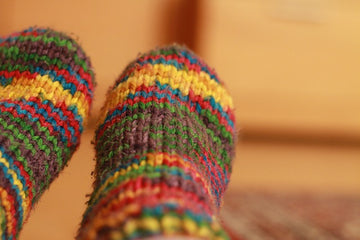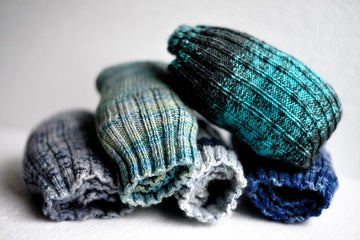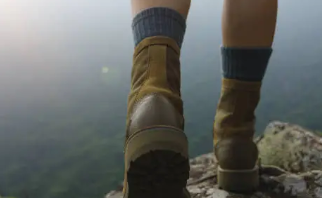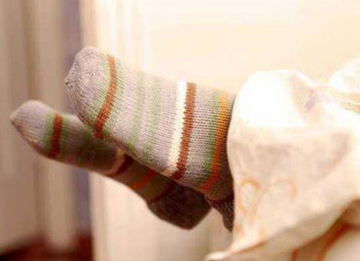
A comfortable pair of socks is something we often take for granted, yet it plays a crucial role in our foot health and comfort. The material of a sock significantly impacts how our feet feel. So, what is the best material for socks? This article will delve into the pros and cons of various sock materials to help you choose the perfect pair.
What Material Are Socks Made of
Socks are typically made from materials like cotton, wool, nylon, polyester, and spandex (elastane). Cotton is breathable and comfortable for everyday wear, while wool is insulating and moisture-wicking, ideal for cold weather. Nylon and spandex add durability and stretch, and polyester is quick-drying, making it great for sports. Bamboo fiber is eco-friendly and soft, while silk is lightweight but less durable. Different materials are chosen depending on the occasion, such as for casual wear, athletic use, or formal events.

Best Sock Material for Sweaty Feet
The best sock materials for sweaty feet are those that are moisture-wicking, breathable, and quick-drying.
- Merino Wool
Merino wool is one of the top choices for sweaty feet. It is a natural fiber that not only wicks moisture away but also regulates temperature, keeping feet dry in both warm and cold conditions. Its natural odor resistance makes it ideal for people who sweat a lot, and it’s soft enough for all-day comfort.
- Bamboo
Another excellent option is bamboo fiber. Bamboo is highly absorbent and has natural antibacterial properties, helping to reduce moisture and fight odor. It's also a sustainable, eco-friendly material that is soft and gentle on the skin, making it a good choice for those with sensitive feet.
- Synthetic Blends (Polyester, Nylon, Spandex)
Synthetic blends, like polyester, nylon, and spandex, are widely used in socks for sweaty feet, especially in athletic and performance socks. These materials are designed to be moisture-wicking and quick-drying, pulling sweat away from the skin and allowing it to evaporate more efficiently. Spandex also adds stretch, ensuring a snug fit that minimizes friction and reduces sweat buildup.
Shop Synthetic Blends Socks

- Coolmax®
Coolmax® is a specialized technical fabric that is commonly used in athletic socks. It’s engineered specifically to improve air circulation and draw moisture away from the skin, keeping feet cool and dry during intense physical activities or in hot weather.
- Olefin (Polypropylene)
Finally, olefin (polypropylene) is a synthetic material that excels at moisture management. It’s hydrophobic, meaning it repels water, which allows it to wick away sweat and dry quickly. This makes it particularly useful for people who sweat heavily during workouts or long days on their feet.
Avoid:
Avoid using socks made from 100% cotton if you have sweaty feet, as cotton absorbs moisture and retains it, leaving feet damp and prone to odor and discomfort throughout the day.
Best Material for Hiking Socks
Read more: Best Hiking Socks in Australia
The best hiking socks are typically made from merino wool blended with synthetic fibers like nylon or polyester for durability and moisture control. Spandex adds stretch for a secure fit, and silk liners can provide extra comfort. These materials ensure that your feet stay dry, warm, and blister-free on any hiking trail.
Best Material for Running Socks
The best running socks are made from synthetic blends like nylon, polyester, and spandex for moisture control, stretch, and durability. For performance, Coolmax® and olefin are excellent choices, while merino wool is ideal for colder conditions. These materials keep feet dry, comfortable, and protected from blisters, helping you perform your best during any run.
Read more: Best Running Socks in Australia
Best Material for Compression Socks
The best compression socks are typically made from nylon and spandex (or elastane), which provide the necessary compression, stretch, and durability. Polyester and olefin are also common for their moisture-wicking properties. These materials ensure that compression socks are effective, comfortable, and suitable for long-term wear in various conditions.
Shop Compression Socks

Best Material for Socks in Winter: Warmest Sock Material
The warmest sock materials are those that provide excellent insulation, moisture-wicking, and breathability to keep feet warm and dry in cold conditions.
- Merino Wool
Merino wool is widely considered the best material for warmth. It provides excellent insulation while also being breathable and moisture-wicking, which helps regulate temperature. Merino wool keeps feet warm in cold weather while preventing overheating, and its natural odor resistance is an added bonus for extended wear.
- Alpaca Wool
Alpaca wool is even warmer than merino wool and is incredibly soft. It’s a luxurious option that offers superior insulation, while still being lightweight and moisture-wicking. Alpaca fibers are also hypoallergenic and resistant to odor, making them a great choice for sensitive skin and cold environments.
- Cashmere
Cashmere is known for its luxurious softness and warmth. It is not as durable as merino or alpaca, but it provides exceptional warmth in cold conditions. Cashmere socks are often used for cozy indoor wear or as a layer in very cold climates.
- Thermolite®
Thermolite® is a synthetic insulation material designed for warmth. It traps heat efficiently while being lightweight and quick-drying. Thermolite socks are great for winter sports and outdoor activities in cold weather.
- Fleece
Fleece is a synthetic material made from polyester that provides excellent insulation. Fleece socks are often used in cold climates or for activities like skiing and winter hiking. They are soft, warm, and breathable, but can be bulkier than wool or other materials.
Best Material for Socks in Summer
When selecting socks for summer, prioritize breathable materials like cotton, bamboo, or wool blends. These lightweight fabrics effectively wick away moisture, keeping your feet cool and dry during warm weather. Avoid synthetic materials like polyester, which can trap heat and moisture, leading to discomfort. By choosing breathable socks, you'll enhance your comfort and prevent overheating during summer activities.
Best Material for Athletic Socks
The best athletic socks are typically made from synthetic blends like nylon, polyester, and spandex, offering moisture control, durability, and a snug fit.
Best Material for Ski Socks
The best ski socks are typically made from a blend of merino wool and synthetic fibers like nylon and polyester for warmth, moisture control, and durability. These materials ensure that ski socks keep feet warm, dry, and comfortable throughout long, active days on the slopes.
- Merino Wool
Merino wool is widely considered the best material for ski socks due to its excellent temperature regulation, moisture-wicking, and odor-resistant properties. It keeps feet warm in cold conditions but prevents overheating, making it ideal for a range of temperatures. Merino wool is also soft, non-itchy, and helps prevent blisters by keeping feet dry.
- Synthetic Blends (Nylon, Polyester, Spandex)
Synthetic fibers like nylon and polyester are commonly blended with merino wool to enhance the durability, moisture management, and quick-drying capabilities of ski socks. These materials also improve the sock’s elasticity and help maintain its shape over time. Spandex or elastane is added for stretch, ensuring a snug fit that won’t bunch up inside the ski boots.
Best Material for Breathable Socks
While 100% cotton is not ideal for high-performance wear due to its moisture retention, cotton blends with synthetic fibers like polyester or spandex can offer better breathability and moisture-wicking properties. Cotton’s softness combined with synthetic materials’ moisture control creates a comfortable and breathable sock.
Best Material for Dress Socks
The best material for dress socks depends on the occasion and climate. Merino wool and cotton are versatile, comfortable, and durable choices for winter, while silk and cashmere add a touch of luxury for formal occasions. Nylon or polyester blends enhance durability and fit, while bamboo offers eco-friendly softness and breathability.
Best Material for Sports Socks
The best material for sports socks should offer moisture-wicking, breathability, cushioning, and durability to keep feet dry and comfortable during physical activities.
For sports socks, the best materials are typically synthetic blends like nylon, polyester, and spandex, which provide excellent moisture management, durability, and stretch. Coolmax® and olefin are great for moisture control and quick drying. Bamboo offers natural breathability and comfort, making it a great option for eco-conscious athletes.
Best Moisture Wicking Sock Material
The best moisture-wicking sock materials include merino wool, Coolmax®, polyester, nylon, and olefin for their ability to keep feet dry and comfortable. Bamboo offers a natural alternative with similar moisture-wicking properties, while acrylic provides additional cushioning and quick-drying benefits.
Best Sock Material for Athlete's Foot
The best sock materials for athlete's foot are those that prioritize moisture-wicking and antibacterial properties, such as merino wool, bamboo, and Coolmax®. Copper- or silver-infused socks offer added antimicrobial protection, while synthetic blends like nylon and polyester can enhance moisture control. Avoid cotton, as it retains moisture and can worsen athlete’s foot symptoms. These materials help keep feet dry, cool, and free from the conditions that promote fungal infections.
Best Sock Material for Smelly Feet
Merino wool is a natural fiber known for its excellent moisture-wicking capabilities. It can absorb moisture while still feeling dry against the skin, which helps prevent the buildup of sweat and odor. Additionally, merino wool has natural antibacterial properties that reduce odor-causing bacteria, making it an ideal choice for managing smelly feet.
Best Sock Material to Prevent Blisters
The best sock materials to prevent blisters are moisture-wicking and breathable, such as merino wool, synthetic blends, and bamboo. However, the fit of your socks and shoes is equally important. Choosing socks with seamless toe seams and wearing well-fitting shoes can significantly reduce your risk of developing blisters.
Best Material for Bed Socks
For optimal sleep comfort, socks crafted from soft and stretchy fabrics is the best choice. For those who tend to feel hot at night, it's advisable to choose socks made from naturally thermoregulating materials like bamboo-derived viscose. Conversely, if you often experience cold feet while you sleep, seek out socks made from warmer materials such as Merino wool or yak down.
FAQ
Are cotton socks good?
Cotton socks are soft and comfortable, making them a popular choice. They can be breathable if made from thin cotton or with a mesh design. However, cotton has drawbacks, such as retaining moisture if not blended with other materials, which can lead to discomfort and odor. Additionally, cotton may not perform as well as materials like merino wool or synthetic blends during high-intensity activities or hot weather.
Is cotton or polyester better for socks?
Cotton socks offer softness and comfort, making them a popular choice. They're also generally more environmentally friendly. However, polyester socks are often more durable and stain-resistant. The best choice depends on your priorities: comfort or durability.
Is 100% merino wool good for socks?
While 100% merino wool socks are excellent, considering a blend can offer additional benefits depending on your specific needs.
- Improved durability: Blending merino wool with nylon or polyester can make the socks more durable and resistant to pilling.
- Enhanced moisture-wicking: Adding synthetic fibers like nylon or polypropylene can improve the sock's moisture-wicking properties, especially for high-intensity activities.
- Enhanced elasticity: Blending merino wool with elastane or spandex can provide better elasticity and a more comfortable fit.
Should socks be 100% cotton?
While 100% cotton socks can be comfortable, they may not always be the best choice, especially for those who struggle with sweaty feet or blisters.
Although cotton can absorb moisture, it can also retain it, leading to discomfort and potentially contributing to blisters.
Depending on the thickness and construction of the cotton, it may not be as breathable as other materials, especially in hot weather or during intense activity.
The combination of moisture and friction can increase the risk of blisters, especially if the cotton socks are not well-fitting or if the wearer has sensitive skin.
To address these issues, it's often beneficial to consider socks made from blends of cotton with other materials.
- Merino wool: Blending cotton with merino wool can provide enhanced moisture-wicking properties, temperature regulation, and odor resistance.
- Synthetic fibers: Adding synthetic fibers like nylon or polyester can improve durability, moisture-wicking, and quick-drying properties.
What kind of socks do podiatrists recommend?
Podiatrists often recommend socks made from acrylic or Coolmax. These materials are breathable and moisture-wicking, helping to keep feet healthy and comfortable.
For foot and heel pain, look for socks with extra padding in the ball of the foot and heel areas. This added cushioning can provide relief and support.
Are cotton or bamboo socks better?
Bamboo socks are generally more breathable than cotton or wool socks. This helps keep feet cool and dry, reducing odor. Bamboo's natural antibacterial properties also help prevent foot odor.
Is merino or cashmere better?
Cashmere typically offers greater warmth and softness compared to merino wool, making it ideal for casual wear, while merino wool is more durable and better suited for activewear due to its moisture-wicking properties and temperature regulation.
Read More
Best Running Socks in Australia
Best Hiking Socks in Australia
Why Do We Wear Socks
Do You Wear Socks with Climbing Shoes
What Color Socks with Brown Shoes
What Socks to Wear with Loafers
What are Grip Socks
What Socks to Wear with Cowboy Boots






